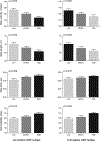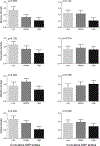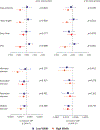Cumulative Blood Pressure Exposure During Young Adulthood and Mobility and Cognitive Function in Midlife
- PMID: 31747780
- PMCID: PMC7135652
- DOI: 10.1161/CIRCULATIONAHA.119.042502
Cumulative Blood Pressure Exposure During Young Adulthood and Mobility and Cognitive Function in Midlife
Abstract
Background: High blood pressure (BP) is a known risk factor for mobility and cognitive impairment in older adults. This study tested the association of cumulative BP exposure from young adulthood to midlife with gait and cognitive function in midlife. Furthermore, we tested whether these associations were modified by cerebral white matter hyperintensity (WMH) burden.
Methods: We included 191 participants from the CARDIA study (Coronary Artery Risk Development in Young Adults), a community-based cohort of young individuals followed over 30 years. Cumulative BP was calculated as the area under the curve (mm Hg×years) from baseline up to year 30 examination. Gait and cognition were assessed at the year 30 examination. Cerebral WMH was available at year 30 in a subset of participants (n=144) who underwent magnetic resonance imaging. Multiple linear regression models were used to assess the association of cumulative BP exposure with gait and cognition. To test effect modification by WMH burden, participants were stratified at the median of WMH and tested for interaction.
Results: Higher cumulative systolic and diastolic BPs were associated with slower walking speed (both P=0.010), smaller step length (P=0.011 and 0.005, respectively), and higher gait variability (P=0.018 and 0.001, respectively). Higher cumulative systolic BP was associated with lower cognitive performance in the executive (P=0.021), memory (P=0.015), and global domains (P=0.010), and higher cumulative diastolic BP was associated with lower cognitive performance in the memory domain (P=0.012). All associations were independent of socio-demographics and vascular risk factors (body mass index, smoking, diabetes mellitus and total cholesterol). The association between cumulative BP and gait was moderated by WMH burden (interaction P<0.05). However, the relation between cumulative BP and cognitive function was not different based on the WMH burden (interaction P>0.05).
Conclusions: Exposure to higher BP levels from young to midlife is associated with worse gait and cognitive performance in midlife. Furthermore, WMH moderates the association of cumulative BP exposure with gait, but not with cognitive function in midlife. The mechanisms underpinning the impact of BP exposure on brain structure and function must be investigated in longitudinal studies using a life course approach.
Keywords: blood pressure; cognition; gait; middle aged; white matter diseases; young adult.
Conflict of interest statement
CONFLICT OF INTEREST DISCLOSURES
None.
Figures



Comment in
-
Midlife Consequences of Cumulative Blood Pressure Exposure: Importance of a Lifespan Approach.Circulation. 2020 Mar 3;141(9):725-727. doi: 10.1161/CIRCULATIONAHA.120.044447. Epub 2020 Mar 2. Circulation. 2020. PMID: 32119589 Free PMC article. No abstract available.
References
-
- Whelton PK, Carey RM, Aronow WS, Casey DE Jr., Collins KJ, Dennison Himmelfarb C, DePalma SM, Gidding S, Jamerson KA, Jones DW, et al. 2017 ACC/AHA/AAPA/ABC/ACPM/AGS/APhA/ASH/ASPC/NMA/PCNA Guideline for the Prevention, Detection, Evaluation, and Management of High Blood Pressure in Adults: Executive Summary: A Report of the American College of Cardiology/American Heart Association Task Force on Clinical Practice Guidelines. Circulation. 2018;138:e426–e483. - PubMed
-
- Harrington F, Saxby BK, McKeith IG, Wesnes K and Ford GA. Cognitive performance in hypertensive and normotensive older subjects. Hypertension. 2000;36:1079–1082. - PubMed
-
- Hubert HB and Fries JF. Predictors of physical disability after age 50. Six-year longitudinal study in a runners club and a university population. Ann Epidemiol 1994;4:285–294. - PubMed
Publication types
MeSH terms
Grants and funding
LinkOut - more resources
Full Text Sources
Other Literature Sources
Medical

